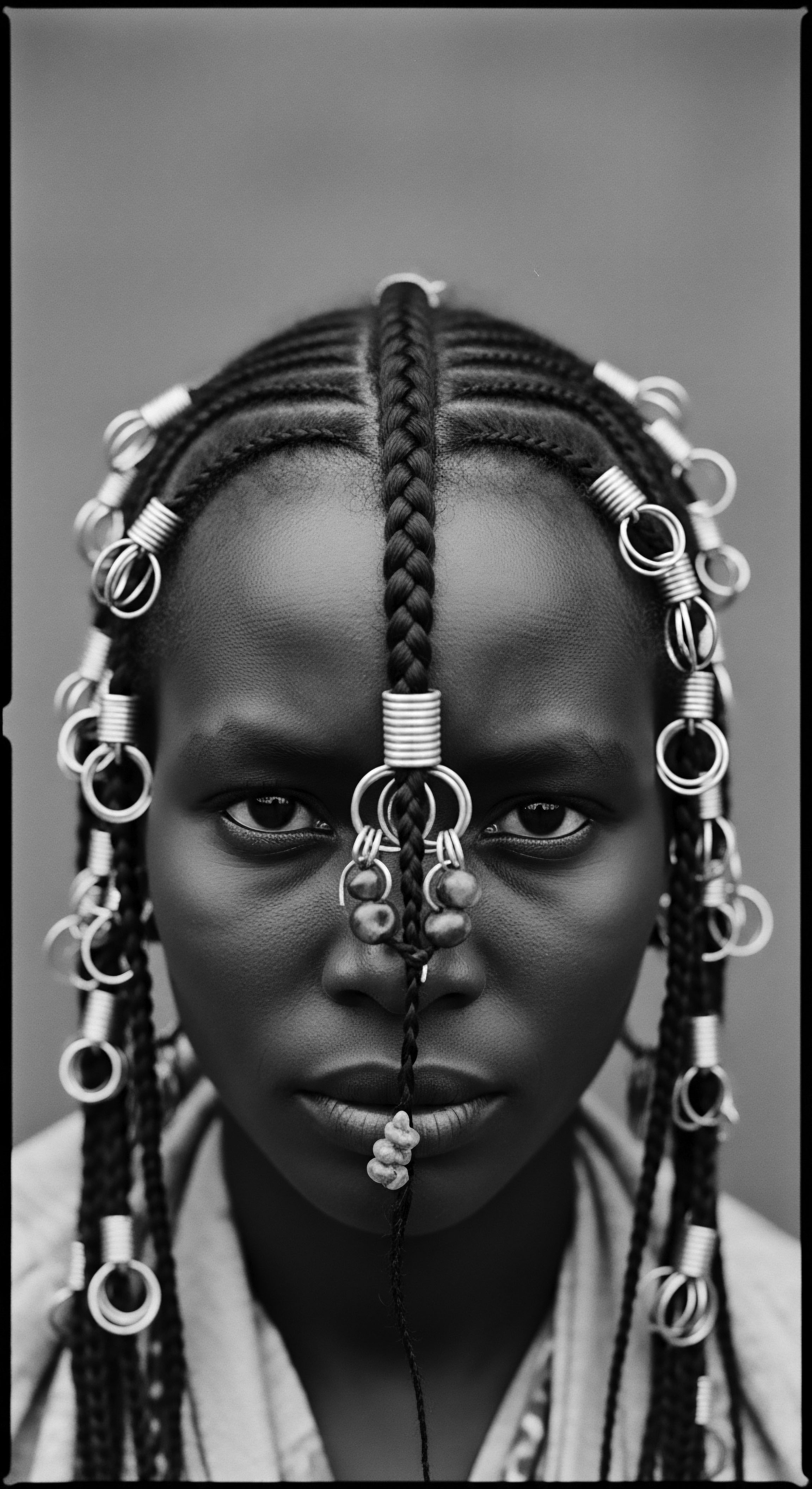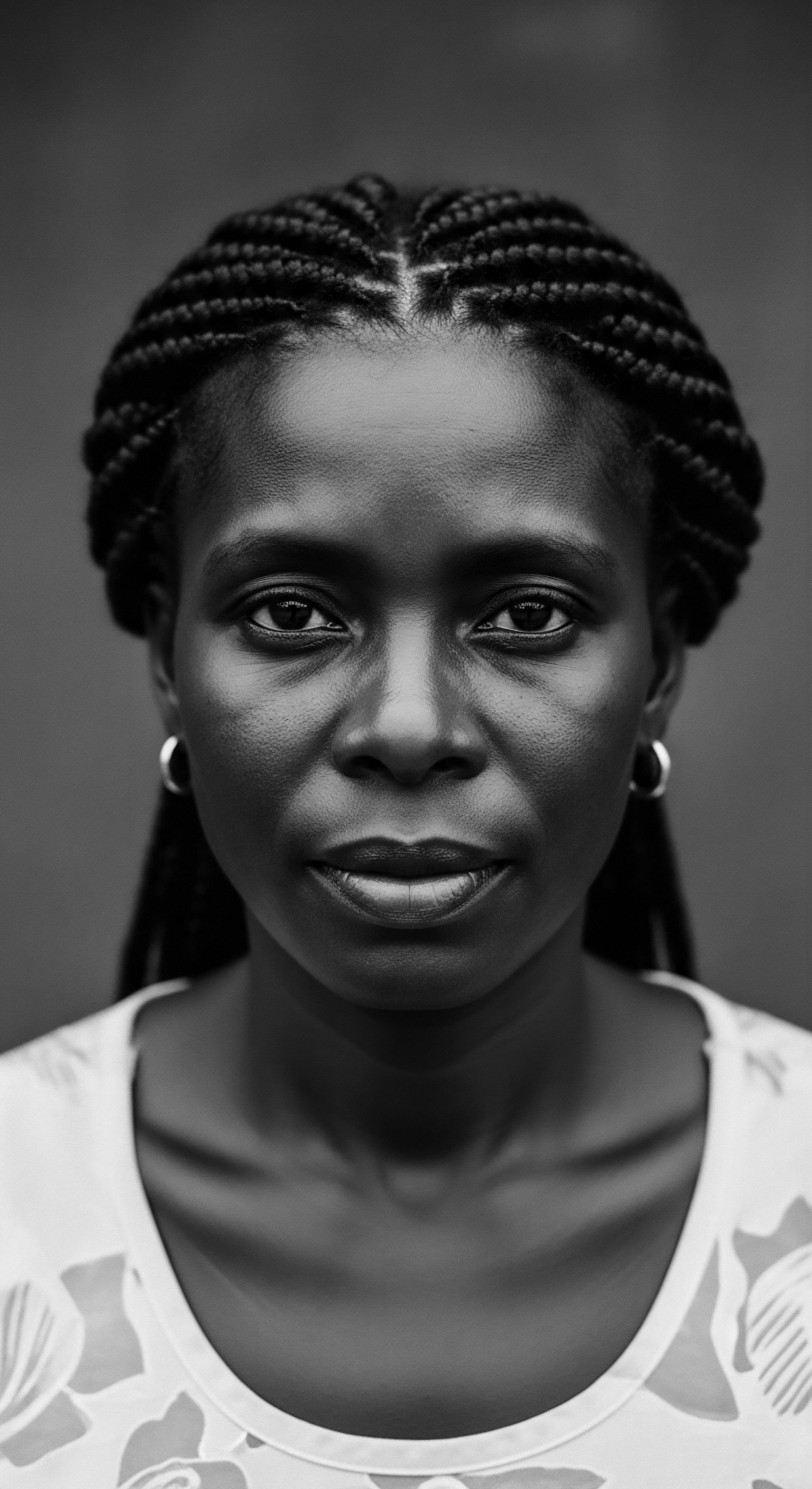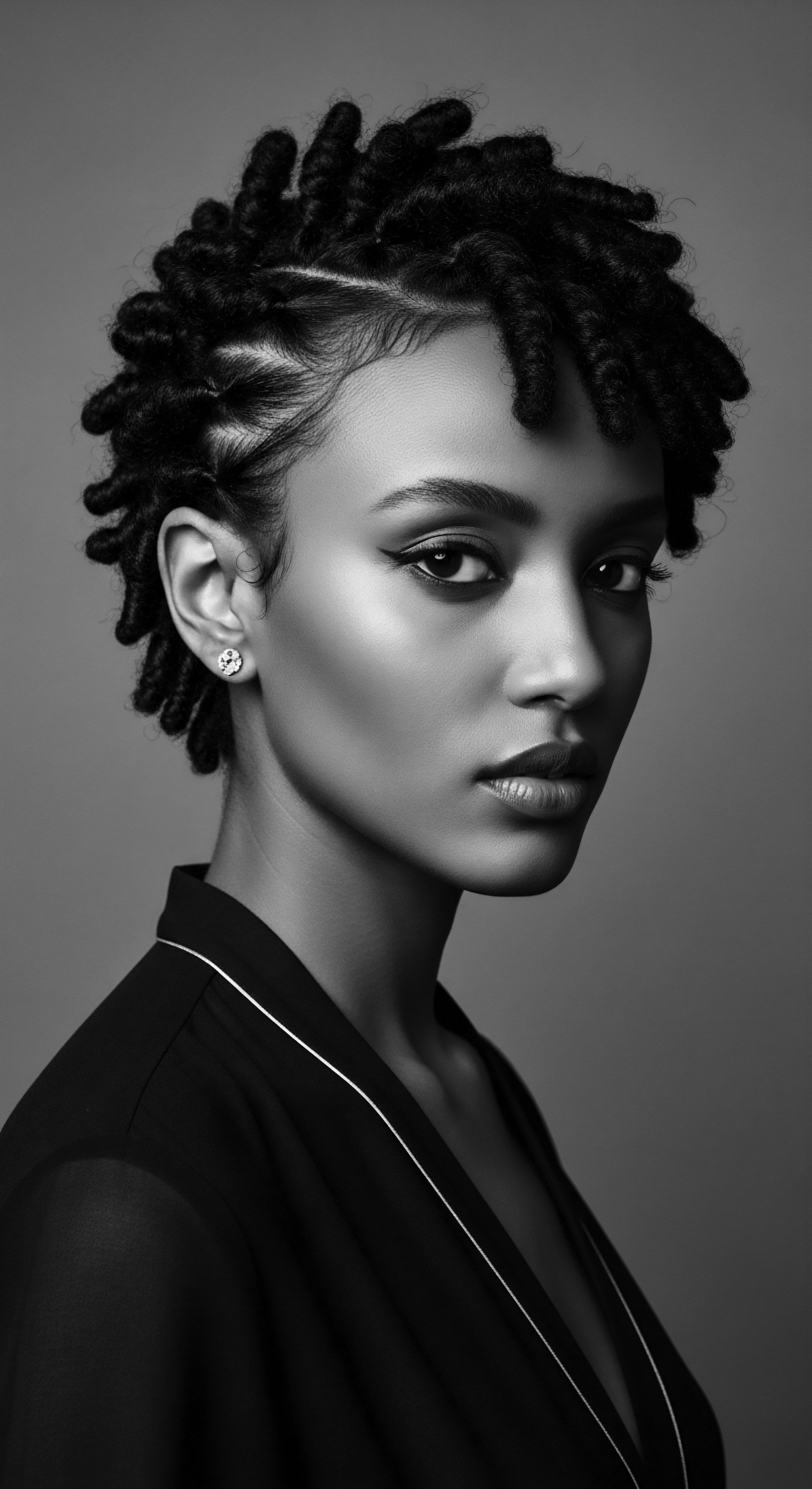
Roots
The very soul of a strand, particularly one sculpted by the intricate twists and turns of texture, holds within its helix a profound memory. This memory speaks of resilience, of beauty forged across continents, and of wisdom inherited through generations. As twilight descended, drawing a hush over ancestral hearths, a quiet understanding settled upon communities with coils, kinks, and waves ❉ the night, while a time for respite, also presented a subtle challenge to the hair’s very life force—its moisture. How, then, did our forebears, those keepers of ancient knowledge, shield these precious strands from the evaporating breath of the sleeping hours?
Their ingenuity, born of necessity and intimacy with the natural world, laid foundations for practices that echo still in our contemporary routines. This deep well of practice represents a living archive, where every twist, every wrap, every anointing oil tells a story of survival and magnificent self-preservation.
Understanding these protective measures begins with a journey into the hair itself, a journey that spans both microscopic science and ancestral observation. Textured hair, a marvel of biological design, possesses a unique architecture. Its elliptical cross-section, coupled with varied curl patterns, means a cuticle layer that tends to lift more readily, offering pathways for moisture to escape. The natural oils, sebum, produced by the scalp, struggle to travel down the length of these winding strands, leaving the ends particularly vulnerable.
This inherent dryness, a biological reality, was keenly observed by ancestors. They understood, without the benefit of modern microscopes, that hair thirsted, especially during periods of prolonged stillness. The answer, often, lay not in complex chemical formulations, but in simple, earth-given resources and time-honored techniques.
Ancestral wisdom recognized the inherent thirst of textured hair, leading to nightly practices that preserved moisture.

The Strand’s Ancestral Architecture and Vulnerability
The journey of a hair strand begins deep within the scalp, in the hair follicle, a tiny organ that shapes the strand’s ultimate form. For individuals with Textured Hair, this follicle is often curved, dictating the spiraling path of the hair shaft as it grows. This helical shape, while visually stunning, influences how natural oils distribute and how moisture is retained. The outermost layer, the cuticle, resembles shingles on a roof.
On straighter hair, these shingles lie relatively flat. On textured strands, they often lift slightly, especially at the curves and bends. This slight elevation, a characteristic of its natural design, provides more surface area for evaporation, a critical factor during the dry stillness of night.
Ancestral communities, whether in the sun-drenched savannas of Africa or the humid Caribbean islands, witnessed this phenomenon. They saw how hair, left uncovered and unprotected through the night, became brittle, lost its luster, and suffered breakage. Their solutions were not accidental; they were the culmination of generations of meticulous observation and experimentation.
These practices were not isolated acts, but interwoven parts of a larger cultural fabric, connecting individuals to their lineage and to the collective knowledge of their people. They understood that the night’s embrace could strip away vital hydration, leading to fragility and diminished vitality.

Ancient Lexicon for Hair Preservation
The language of ancestral hair care is rich, often interwoven with terms that describe both the physical act of care and its spiritual or communal significance. While direct translations for ‘moisture loss overnight’ might not exist in ancient tongues, the practices themselves spoke volumes. Terms like Wrapping, Binding, Oiling, and Plaiting carried implicit meanings of preservation and protection. These words were not merely descriptive; they were verbs of deep care, of an intimate relationship with one’s hair.
- Kiko ❉ A term used in some West African traditions, referring to the act of coiling hair tightly to preserve its shape and moisture.
- Sutura ❉ In some North African contexts, a word encompassing modesty and protection, often applied to hair coverings that also served a practical function overnight.
- Almond Oil ❉ Widely used across Mediterranean and North African regions, valued for its emollient properties that helped seal hair cuticles.
The choice of specific materials for hair coverings or natural emollients was also dictated by the local environment and available resources. From finely woven cloths to animal skins, from rich Shea butter cultivated in West Africa to fragrant coconut oil in the Caribbean, each ingredient and tool held a purpose, a testament to the symbiotic relationship between people, their hair, and their immediate surroundings. These were not mere products; they were extensions of ancestral wisdom, distilled into tangible forms.

Ritual
The act of securing textured hair before sleep was never a mundane task; it was a ritual, imbued with intention and generational wisdom. These practices, honed over centuries, served not only a practical purpose of preventing moisture escape and mechanical damage but also held deep cultural resonance. They were quiet conversations with the self, acknowledgements of heritage, and preparations for the day to come. From intricate braiding patterns to careful wraps, each method was a testament to the profound understanding of how textured strands behaved, particularly when exposed to the friction and dehydration that nighttime could bring.
One might consider the simple act of braiding. Throughout various African societies and across the diaspora, braiding, in its myriad forms, has been a cornerstone of hair care and cultural expression. When applied before sleep, braids—whether large cornrows, individual plaits, or twists—served as a primary defense against moisture loss. They effectively grouped strands together, minimizing the surface area exposed to the air and reducing tangling caused by movement against rough sleeping surfaces.
This containment significantly slowed the rate of water evaporation from the hair shaft, allowing the natural oils and any applied emollients to remain undisturbed. The tension created by the braid also gently stretched the hair, offering a slight elongation that could, for some, reduce shrinkage upon waking, making morning styling a gentler affair.

The Unseen Science of Nighttime Braids
The efficacy of braids extends beyond mere containment. From a scientific perspective, braids reduce the friction that occurs when hair rubs against pillows, blankets, or even other strands. This friction is a major contributor to cuticle damage, which, in turn, allows precious moisture to escape. By consolidating the hair into fewer, larger sections, the mechanical stress on individual strands is greatly minimized.
Consider the practice of Cornrowing, a technique with deep roots in West African traditions, often serving as both an artistic expression and a protective style. When worn overnight, cornrows lay flat against the scalp, further shielding the hair from external elements and ensuring that any applied balms or oils remained in close contact with the hair and scalp. This close contact amplified the protective benefits, allowing ingredients like Shea Butter or Argan Oil to slowly absorb, coating the hair shaft and fortifying its natural barrier.
The historical record, while often sparse in detailed accounts of daily routines, provides glimpses into these practices. Enslaved Africans, forcibly brought to the Americas, carried with them the memory of these techniques. Braiding, beyond being a symbol of identity and resistance, became a survival strategy for their hair, protecting it from the harsh conditions of labor and the rudimentary care available.
The very act of braiding at night, often done in communal settings, served as a quiet act of defiance, a continuation of self-care and cultural preservation against immense adversity. The knowledge of how to care for their unique hair textures, including how to protect it overnight, was a precious inheritance, passed down through whispers and tactile teaching.
Braiding, a cornerstone of heritage hair care, minimized friction and maximized moisture retention during sleep.

Wraps and Coverings ❉ A Gentle Shield
Beyond braiding, the use of head wraps and bonnets stands as another cornerstone of ancestral nighttime protection. These coverings, made from various materials, served as a physical barrier between delicate textured strands and abrasive sleeping surfaces. Cotton, while common, was recognized for its absorbent nature, which could draw moisture from the hair.
This understanding led to the preference for smoother, less absorbent materials, or the strategic layering of materials. In many cultures, the simple yet profound act of wrapping the hair was often accompanied by the application of oils or butters.
The material choice was often dictated by what was available and effective. Consider the use of Silk or Satin. While perhaps not universally accessible in ancient times, the properties that make them ideal for modern bonnets—their smooth surface and low absorbency—were intuitively understood.
Where these were scarce, alternatives like finely woven linen or even softer animal hides might have been chosen, or preparatory steps taken to mitigate moisture loss. The wrap or bonnet acted as a micro-environment, trapping humidity close to the hair, preventing the rapid desiccation that could occur in drier sleeping conditions.
| Technique Braiding/Plaiting |
| Ancestral Context Prevalent across various African communities for style, status, and practical care. Knowledge persisted through the diaspora. |
| Moisture Protection Mechanism Groups hair, reduces friction, minimizes exposed surface area for evaporation, secures applied emollients. |
| Technique Hair Wrapping/Covering |
| Ancestral Context Common across many cultures for modesty, protection from elements, and preservation of elaborate styles. |
| Moisture Protection Mechanism Creates a protective barrier against abrasive surfaces, maintains a humid micro-climate around the hair. |
| Technique Oil/Butter Application |
| Ancestral Context Ubiquitous use of indigenous oils (Shea, Coconut, Palm, Olive) and plant-based butters for skin and hair health. |
| Moisture Protection Mechanism Seals the cuticle, forms an occlusive layer, prevents water evaporation, nourishes the hair shaft. |
| Technique These practices, rooted in observational knowledge, underscore the enduring effectiveness of traditional approaches to textured hair care. |

Relay
The generational relay of knowledge, often unspoken and demonstration-based, ensured the continuity of these essential nighttime hair practices. It was in the hushed intimacy of shared spaces—communal sleeping areas, the family compound, or the quiet corner of a dwelling—that the techniques were passed from elder to youth. This was not a formal curriculum but an organic transmission, where observation and direct participation cemented understanding.
The nuances of how tightly to braid, the precise amount of oil to apply, or the most effective way to tie a headwrap were learned through repeated observation and hands-on guidance. This intimate form of education forged a powerful connection to Textured Hair Heritage.
The materials employed in these ancestral protective practices were, as mentioned, deeply tied to the environment. The richness of Shea butter, derived from the nuts of the African Shea tree, and coconut oil, a staple in many tropical coastal regions, are prime examples. These substances, beyond being readily available, possessed inherent properties that science now affirms as highly beneficial for moisture retention.
They are natural emollients and occlusives. Emollients smooth the hair’s surface, helping to flatten the cuticle scales, while occlusives form a protective barrier that seals moisture within the hair shaft, preventing it from escaping into the dry night air.
A powerful historical example of this deep understanding comes from the Wolof women of Senegal, documented in early ethnographic accounts. Their intricate Braiding Patterns, often adorned with cowrie shells or amber beads, were not only artistic statements but also highly functional protective styles. These styles were often maintained for weeks, requiring specific nightly care to preserve their integrity and the moisture of the hair beneath. The use of natural oils, applied directly to the scalp and hair, followed by wrapping with fine cloths, was a consistent part of this regimen.
These practices, observed by early ethnographers, speak to a sophisticated system of hair management that directly addressed moisture preservation. (Diawara, 2007)
Generational transmission of hair care practices ensured the enduring power of ancestral moisture preservation.

Natural Occlusives and Emollients ❉ Gifts of the Earth
The ancestral knowledge of natural ingredients stands as a testament to profound observation. They understood the differences in how various plant-based substances interacted with the hair.
- Shea Butter ❉ From West Africa, this butter is rich in fatty acids and vitamins. It creates a semi-occlusive barrier on the hair shaft, effectively reducing water loss while also softening and conditioning the strands. Its properties made it ideal for nightly application to coils and curls.
- Coconut Oil ❉ Widely used in tropical regions, this oil has a unique molecular structure that allows it to penetrate the hair shaft, reducing protein loss. When applied before sleep, it helps to fortify the hair from within and provide a protective outer layer, minimizing moisture evaporation.
- Palm Oil ❉ A traditional African staple, red palm oil, particularly, is packed with antioxidants and vitamins. It acts as a sealant, coating the hair to prevent water from escaping and offering protection against external aggressors during the night.
These practices were not merely about coating the hair. They involved specific application techniques, often working the oils into the scalp and down the hair shaft, sometimes with gentle massage to stimulate blood flow and aid absorption. The combination of protective styling (braids, twists, wraps) with these natural occlusives created a synergistic effect, maximizing moisture retention and minimizing damage over extended periods, particularly during sleep. This holistic approach, blending physical protection with natural nourishment, speaks to a deep, integrated understanding of hair health.

What Did Nightly Hair Protection Mean for Identity?
The implications of these ancestral nighttime hair practices extended far beyond mere cosmetic benefits. They were integral to identity, cultural continuity, and personal agency. For textured hair, which has often been politicized and subjected to scrutiny, these protective rituals became acts of self-affirmation. Preserving the health and beauty of one’s hair, even in the private moments of preparing for sleep, affirmed one’s connection to an ancestral past, to a lineage that valued and understood its unique strands.
This link to Ancestral Practices provided a psychological anchor, particularly during periods of upheaval and displacement. The ritual of preparing hair for the night could serve as a moment of grounding, a silent reaffirmation of self and community, a quiet act of resistance against external pressures.
The communal aspect of hair care, often seen in braiding circles or shared nighttime routines, also forged bonds. It was a space for storytelling, for sharing wisdom, and for mutual support. The protection of hair overnight, therefore, was not just an individual pursuit of moisture retention; it was a collective investment in the health, beauty, and resilience of the community’s visible heritage. This collective understanding, passed down through generations, solidified these practices as indispensable parts of a broader cultural legacy.

Reflection
The legacy of ancestral hair practices, particularly those aimed at preserving moisture overnight, continues to speak volumes to us today. It reminds us that profound wisdom often resides not in the latest laboratory discovery, but in the enduring observations and patient ingenuity of those who walked before us. The quest to shield textured strands from the night’s subtle drying touch was, and remains, a testament to a deep, inherent respect for the hair itself—viewed not as a mere adornment, but as a living extension of self, a repository of history, and a vibrant declaration of Heritage.
These ancient rituals, whether a simple twist, a careful plait, or the strategic application of a revered butter, offer more than just practical solutions for moisture retention. They invite us to connect with a timeless rhythm of care, to honor the hands that first practiced these arts, and to appreciate the profound link between our present-day hair routines and the rich tapestry of our ancestral past. The whispers of these nighttime practices carry forward, a continuous melody of resilience and beauty, guiding us toward a more soulful, informed approach to our strands. Our hair, truly, is a living, breathing archive of ancestral wisdom, continually teaching us the power of gentle protection and deep reverence.

References
- Diawara, M. (2007). African Cinema ❉ Politics and Culture. Indiana University Press.
- Opoku, A. A. & Opoku, R. (2014). African Traditional Religion ❉ An Introduction. Paulines Publications Africa.
- Roberson, S. (2010). Hair Story ❉ Untangling the Roots of Black Hair in America. St. Martin’s Griffin.
- Byrd, A. D. & Tharps, L. L. (2001). Hair Story ❉ Untangling the Roots of Black Hair in America. St. Martin’s Press.
- Akerele, O. & Otevall, J. (1993). Natural Resources in African Development ❉ A Case Study of Shea Butter in Burkina Faso. African Centre for Technology Studies.
- Nwafor, D. I. (2018). Indigenous African Hair Care Practices and Their Contemporary Relevance. Journal of African Cultural Studies, 30(2), 201-218.
